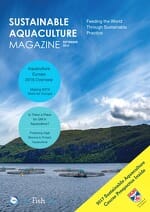In 2007 an algal bloom in the North Puget Sound in the US caused $2 million worth of damage to salmon farms and in 2009 harmful blooms caused $25 million in damage and aquaculture farms in South Korea received $95 million worth of damage because of algal blooms.
In 1998, Chattonella – red tides – killed 350 tonnes of Norwegian farmed salmon and in 2001 Karenia Mikimotoi killed 500,000 salon in Shetland.
The most recent incident was earlier this year in Chile where the salmon aquaculture giant Marine Harvest reported 100 per cent mortality on some of its salmon farms because of blooms.
Speaking at the Oceanology International exhibition and conference in London, Hans Wouters, a director of the Dutch based marine surveillance company, Blue Leg Monitor, said: “There are hotspots for harmful algal blooms occurring all over the world.”
He said they occur in eutrophication sources close to the coast and in areas of high temperature areas and near aquaculture operations.
According to Blue Leg Monitor, the insurance company Swiss RE estimates that harmful algae cause damages of €65 million per year on average for insured salmon farm companies.
And it predicts that the true total damages to salmon aquaculture is six fold or €380 million.
Blue Leg Monitor said that there is also other, non-quantified damages to shellfish- and shrimp aquaculture.
Scientists in the field expect that the incidence of harmful algae will increase globally as a result of the combination of various factors including global warming, intensified rainfall leading to increasing nutrient run off, intensive agriculture run off, and the spread of exotic species of algae by untreated ship ballast water.
However, one way to help mitigate the potential damage is to use surveillance systems to monitor the intensity, the drift and the speed of the drift of the blooms to be able to forecast potential dangers.
Mr Wouters said that satellites have started to be used to help predict the species in the water and this gives the key parameters to let scientists see the ecological nature of the water.
These systems have been used to help monitor and predict the potential for algae grown around mussel farms in the Netherlands.
A consortium, led by BlueLeg Monitor, has carried out a contract with the European Space Agency (ESA) under the Integrated Application Promotion (IAP) programme to develop services for the monitoring of blue green algae or cyanobacteria under the name CyMonS: cyanobacteria monitoring services.
For Dutch inland waters, bad water quality due to cyanobacteria blooms are an increasing problem. The cyanobacteria can form thick floating mats, or ‘scum’, leading to a bad smell. Moreover, cyanobacteria can produce toxins, leading to starving fish as well as other damage.
However, he said that while giving an over picture, satellites do not guarantee real time analysis.
However, by using the satellite pictures the quality of the water can also be monitored in real time through examining its light reflection qualities and with the use of spectral graphs the density of the chlorophyll and suspended solids in the water can be determined.
Mr Wouters said that Blue Leg Monitor has developed a systems with a zoom-in approach where satellite data is used to monitor large areas to timely identify water quality anomalies combined with in-situ data collection to identify the exact nature of the anomaly.
The system uses static monitors placed around areas of aquaculture production and it also uses multiple hand held field monitors called WISP-3s (Water Insight Spectrometers) with other measurements and satellite-based maps to provide data with a high spatial scale so that the origins of harmful blooms can be better understood.
Near real time data and their interpretation is provided to the end users, enabling them to act if and when required.
The system is being used on Vancouver Island by Marine Harvest as a test and the company is also looking to expand the monitoring to the Netherlands for mussel farms to determine where the mussels will grow the fastest by determining the nutrients in the water.
Mr Wouters said that monitoring systems that can determine the types and volumes of harmful algae, such as Heterosigma A, that kills fish will allow the aquaculture companies to identify hot spots and monitor the algae’s progress and instigate measures to mitigate the damage.
Also speaking at Oceanology International, Dr Peter Miller from the Plymouth Marine Laboratory explained that a similar project in partnership with the University of Exeter, SAMS and CEFAS and sponsored by the BBSRC and NERC, had been working on an early warning system for salmon farms and is working on developing tools for shellfish farmers.
He said that environmental events such a nutrient run offs from agriculture that reduce the quality of water in and around aquaculture farms have significant impacts including preventing shellfish being farmed.
The ShellEye research project is developing tools to help shellfish farmers monitor and forecast water quality events that could have a negative impact on the shellfish.
The project, like the Blue Leg Monitor studies, is also using satellite imaging and adding this to meteorological data to monitor the water quality relating to harmful algal blooms and microbiological events.
The research is developing advanced water quality bulletins that can be used by the shellfish farmers.
By monitoring the microbiological status of the water through spectral imaging the system is also expected to be able to give early warnings for E.coli and norovirus water contamination.
The research also employs in-situ buoys looking at the sediment plumes around the coast and in the rivers to develop a risk picture for the movement to the algae and sediment.
Dr Miller said that as more and more information is gathered about the movement of the algae and sediment, then more detailed pictures can be built to produce predictive models.
 This article was taken from the September 2016 Sustainable Aquaculture Magazine.
This article was taken from the September 2016 Sustainable Aquaculture Magazine.




